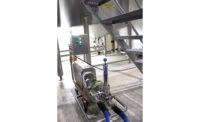
Jan Eudy, corporate quality assurance manager
Cintas Corp., Cincinnati
Selecting the proper personal protective equipment is a key step in protecting your employees, processes and products.
The industry standards governing the food industry have been revised and/or will be revised in 2012. The 2012 version of NFPA 70E standard was released in August 2011. The IFS (International Food Standard), BRC (British Retail Consortium) standard and SQF (Safe Quality Food) 2000 standard recognized in North America by the Global Food Safety Initiative will also be revised in 2012.
The task of implementing and executing compliance of multiple divergent standards (OSHA, FDA, USDA, etc.) can be daunting. The implementation and execution of the Global Food Safety Initiative standards requires food industry operators to wear a garment system compatible with the food industry to prevent contamination of the products and processes during manufacturing. These garments must be precision laundered in a laundry that has implemented and maintains a HACCP-based validated laundry process.
What is NFPA 70E?
The 2012 version of the NFPA 70E standard that was issued on Aug. 31, 2011 addresses the electrical safety requirements for all employees who install, maintain or repair electrical systems. It recognizes the hazards associated with the use of electrical energy and includes guidelines to take precaution against injury or death. Specifically, compliance to NFPA 70E requires that all personnel working on electrical equipment operating at or > 50 V to wear arc-flash protective garments to prevent injury. Arc-flash is an electric current that passes through the air when the insulation between electrified conductors can no longer withstand the applied voltage. A flash can last less than a second, and its results can be severe and even lead to fatalities.
Compliance to NFPA 70E 2012
Compliance to NFPA 70E in any company begins with a risk assessment of the hazards associated with the tasks employees perform. The 2012 standard lists the various tasks and assigns a hazard/risk category (HRC) for each of these tasks. Within each HRC, there is a minimum arc rating required for the protective garments. The arc rating, or arc thermal performance value (ATPV), measured in cal/cm2, represents the incident energy on a fabric or material that results in a sufficient heat transfer through the fabric or material to cause the onset of a second-degree burn.
After conducting the hazard risk assessment, one must consider the following toward the final objective of properly protecting your employees:
• Selecting the proper personnel protective equipment (PPE)
• Caring for and repairing the PPE
Selecting the proper personnel protective equipment
Typical food processing garments constructed of arc-rated fabric can meet NFPA 70E HRC 2, provided the garments are 8 cal/cm2 or higher. Heavy-duty leatherwork shoes provide some arc-flash protection to the feet and must be used in all exposures greater than 4 cal/cm2. Additionally, construction features such as no pockets or buttons must be considered when selecting food processing arc-rated garments to comply with FDA food code 2-304.11 and the GFSI standards to minimize the risk of food contamination.
Employees working in the food processing industries may also wear disposable or reusable arc-rated hairnets, face shields, safety glasses, voltage-rated gloves and use tools to enhance compliance to NFPA 70E. In most circumstances, arc-rated balaclavas must be worn with the arc-rated face shield, or an arc-rated hood is permitted instead of the arc-rated balaclava and face shield. The arc-rated face shield must wrap around to protect the face, chin, forehead, ears and neck areas. Research and development is ongoing to find compliant materials for food industry applications.
Garment care
Next in determining how to properly protect employees, one must decide how to care and repair the PPE. The arc-rated fabric must be precision laundered using a validated laundry process to maintain the integrity of the arc-rated garments. Home laundering is not recommended. Wash chemical formulas must be validated to assure that soils and wash chemical residuals are removed thoroughly with adequate rinses. Chemical residuals of detergents and additives, such as fabric softeners, negate the effectiveness of the arc-rated fabrics. Additionally, food processing companies are concerned with the risk of cross-contamination from home laundering to the manufacturing facility and vice versa. The food processing garments must be inspected and repaired correctly with similar arc-rated fabrics to achieve sanitation and safety requirements of the food processing industry.
Why is NFPA 70E important?
Automation is prevalent in any industry, including food processing. Constant preventive and corrective maintenance of the automated systems create processing efficiencies and increase profits. However, to protect the food processing employees maintaining and operating these automated systems, employers must assess the risk of potential arc-flash and establish the safe arc-flash boundaries in the production process. Training for all employees, including temporary and/or part-time workers, and auditing for implementation and effectiveness, is a key element in compliance with all safety and food industry standards.
Documenting the program
The final step to compliance is the training of all employees on arc-flash protection and the appropriate use of the PPE based on all documentation of the food processing arc-rated garment system supporting the selection, care and repair of the PPE. This is achieved with specific training according to the employees’ assigned job function and tasks.
Integration is key
An integrated program of the safety of the food processing operators/electricians working around the equipment (based on NFPA 70E requirements) with the sanitation standard operating procedures (based on the GFSI standards) must be derived through the risk assessment. Once this program has been implemented, it must be constantly reviewed and maintained to the current industry standards. Compliance to the latest industry standards is the way to protect your employees, your processes, your products and ultimately your brand.
